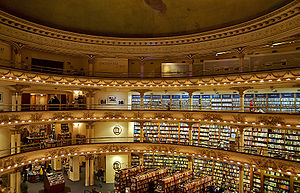
El Ateneo
Encyclopedia

Buenos Aires
Buenos Aires is the capital and largest city of Argentina, and the second-largest metropolitan area in South America, after São Paulo. It is located on the western shore of the estuary of the Río de la Plata, on the southeastern coast of the South American continent...
, Argentina
Argentina
Argentina , officially the Argentine Republic , is the second largest country in South America by land area, after Brazil. It is constituted as a federation of 23 provinces and an autonomous city, Buenos Aires...
.
Overview
Situated at 1860 Santa Fe AvenueSanta Fe Avenue
Avenida Santa Fe is one of the principal thoroughfares in Buenos Aires, Argentina. The artery is essential to the imaginary axis of Barrio Norte in Buenos Aires, comprising the areas influenced by the route of the avenue through Retiro, Recoleta and Palermo neighborhoods, it is considered one of...
in Barrio Norte
Barrio Norte, Buenos Aires
Barrio Norte is the informal name given to a part of Buenos Aires centering around Santa Fe Avenue and the Recoleta district.Recoleta, Belgrano and Palermo, are within a region with a per capita immediately comparable with that of many European cities-Overview:An unofficial neighborhood, Barrio...
, the building was designed by the architects Peró and Torres Armengol for the empresario Max Glucksman (1875-1946), and opened as a theatre named Teatro Gran Splendid in May 1919. The ecleticist building features ceiling frescoespainted by the Italian artist Nazareno Orlandi, and caryatids sculpted by Troiano Troiani (whose work also graces the cornice along the Buenos Aires City Legislature
Buenos Aires City Legislature
The Buenos Aires City Legislature is a central part of the Government of the City of Buenos Aires, as well as an architectural landmark in the city's Montserrat section.-History:...
.
The theatre had a seating capacity of 1,050, and staged a variety of performances, including appearances by the tango artists Carlos Gardel
Carlos Gardel
Carlos Gardel was a singer, songwriter and actor, and is perhaps the most prominent figure in the history of tango. He was born in Toulouse, France, although he never acknowledged his birthplace publicly, and there are still claims of his birth in Uruguay. He lived in Argentina from the age of two...
, Francisco Canaro
Francisco Canaro
Francisco Canaro was an Uruguayan-Argentine violinist and tango orchestra leader.His parents, Italians emigrated to Uruguay, and later - when Francisco Canaro was less than 10 years old, they emigrated to Buenos Aires in the late nineteenth century. Canaro was born in San José de Mayo, Uruguay,...
, Roberto Firpo
Roberto Firpo
Roberto Firpo was an Argentine tango pianist, composer and leader.Firpo was born in the Flores district of Buenos Aires, where his father owned a grocery store...
and Ignacio Corsini
Ignacio Corsini
Ignacio Corsini was a well-known Argentine folklore and tango vocalist.-Life and work:Andrés Ignacio Corsini was born in Troina, a village in the Enna Province of Sicily, in 1891. He was the illegitimate son of Socorro Salomone and a local man whose identity was never revealed publicly—save for...
. Glücksman started his own radio
Radio in Argentina
Radio in Argentina is an important facet of the nation's media and culture. Radio, which was first broadcast in Argentina in 1920, has been widely enjoyed in Argentina since the 1930s. Radio broadcast stations totaled around 150 active AM stations, 1,150 FM stations, and 6 registered shortwave...
station in 1924 (Radio Splendid), which broadcast from the building where his recording company, Nacional Odeón, made some of the early recordings of the great tango singers of the day. In the late twenties the theatre was converted into a cinema, and in 1929 showed the first sound film
Sound film
A sound film is a motion picture with synchronized sound, or sound technologically coupled to image, as opposed to a silent film. The first known public exhibition of projected sound films took place in Paris in 1900, but decades would pass before sound motion pictures were made commercially...
s presented in Argentina.
The ornate former theatre was leased by Grupo Ilhsa in February 2000. Ilhsa, through Tematika, owns El Ateneo and Yenny booksellers (totaling over 40 stores), as well as the El Ateneo publishing house. The building was subsequently renovated and converted into a book and music shop under the direction of the architect Fernando Manzone; the cinema seating was removed and in its place book shelves were installed. Following refurbishment works, the 2,000 m² (21,000 ft²) El Ateneo Grand Splendid became the group's flagship store, and in 2007 sold over 700,000 books; over a million people walk through its doors annually.
Chairs are provided throughout the building, including the still-intact theatre boxes, where customers can dip into books before purchase, and there is now a café on the back of what was once the stage. The ceiling, the ornate carvings, the crimson stage curtains, the auditorium lighting and many architectural details remain. Despite the changes, the building still retains the feeling of the grand theatre it once was. The Guardian
The Guardian
The Guardian, formerly known as The Manchester Guardian , is a British national daily newspaper in the Berliner format...
, a prominent British periodical, named El Ateneo second in its 2008 list of the World's Ten Best Bookshops.

